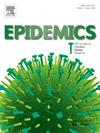利用谷歌流动性和大流行前接触调查估计COVID-19大流行的社会接触率
IF 2.4
3区 医学
Q2 INFECTIOUS DISEASES
引用次数: 0
摘要
在2019冠状病毒病大流行期间,经常使用汇总的流动性数据来估计不断变化的社会接触率。传染病建模者采用大流行前的接触矩阵,并利用大流行时期的流动性数据对其进行转换,试图预测大规模行为变化对接触率的影响。本研究探索了这种转变的最准确方法,使用大流行时期的接触调查作为基础真相。我们比较了四种合成接触矩阵的缩放方法:两种使用拟合回归模型,两种使用“naïve”迁移率或迁移率平方模型。回归模型使用CoMix接触调查和英国2020年3月至2021年3月的谷歌流动性数据进行拟合。然后使用这四个模型来缩放合成接触矩阵(流行病前行为的表示),使用来自英国、比利时和荷兰的流动性数据来预测给定流动性水平下“工作”和“其他”环境中预期的接触人数。然后,我们比较了从四个模型估计的部分再生产数量与直接从CoMix接触矩阵计算的三个国家的部分再生产数量。每个模型的准确性用均方根误差来评估。拟合的回归模型比naïve模型有更准确的预测,即使模型应用于来自英国、比利时和荷兰的样本外数据。在所有被调查的国家中,线性拟合回归模型是最准确的,而单独使用流动性的naïve模型是最不准确的。在没有可用资源进行接触调查的情况下,试图估计大流行期间的社会接触率时,使用符合另一种大流行背景数据的模型可能比使用仅基于流动数据的“naïve”模型更好。如果使用naïve模型,迁移率的平方可能比迁移率本身更好地预测接触率。本文章由计算机程序翻译,如有差异,请以英文原文为准。

Estimating social contact rates for the COVID-19 pandemic using Google mobility and pre-pandemic contact surveys
During the COVID-19 pandemic, aggregated mobility data was frequently used to estimate changing social contact rates. By taking pre-pandemic contact matrices, and transforming these using pandemic-era mobility data, infectious disease modellers attempted to predict the effect of large-scale behavioural changes on contact rates. This study explores the most accurate method for this transformation, using pandemic-era contact surveys as ground truth. We compared four methods for scaling synthetic contact matrices: two using fitted regression models and two using “naïve” mobility or mobility squared models. The regression models were fitted using the CoMix contact survey and Google mobility data from the UK over March 2020 – March 2021. The four models were then used to scale synthetic contact matrices—a representation of pre-pandemic behaviour—using mobility data from the UK, Belgium and the Netherlands to predict the number of contacts expected in “work” and “other” settings for a given mobility level. We then compared partial reproduction numbers estimated from the four models with those calculated directly from CoMix contact matrices across the three countries. The accuracy of each model was assessed using root mean squared error. The fitted regression models had substantially more accurate predictions than the naïve models, even when models were applied to out-of-sample data from the UK, Belgium and the Netherlands. Across all countries investigated, the linear fitted regression model was the most accurate and the naïve model using mobility alone was the least accurate. When attempting to estimate social contact rates during a pandemic without the resources available to conduct contact surveys, using a model fitted to data from another pandemic context is likely to be an improvement over using a “naïve” model based on mobility data alone. If a naïve model is to be used, mobility squared may be a better predictor of contact rates than mobility per se.
求助全文
通过发布文献求助,成功后即可免费获取论文全文。
去求助
来源期刊

Epidemics
INFECTIOUS DISEASES-
CiteScore
6.00
自引率
7.90%
发文量
92
审稿时长
140 days
期刊介绍:
Epidemics publishes papers on infectious disease dynamics in the broadest sense. Its scope covers both within-host dynamics of infectious agents and dynamics at the population level, particularly the interaction between the two. Areas of emphasis include: spread, transmission, persistence, implications and population dynamics of infectious diseases; population and public health as well as policy aspects of control and prevention; dynamics at the individual level; interaction with the environment, ecology and evolution of infectious diseases, as well as population genetics of infectious agents.
 求助内容:
求助内容: 应助结果提醒方式:
应助结果提醒方式:


